Assessment of Bushfire Management in Australia: LB5235
VerifiedAdded on 2022/09/06
|7
|1276
|18
Report
AI Summary
This report, prepared for the Applied Research Project (LB5235), focuses on the critical issue of bushfire management in Australia, particularly the measures and precautions taken by the government before fire outbreaks. The study investigates the existing literature, including journal articles, to understand the government's approach to bushfire prevention. It examines the role of various agencies, programs, and policies, such as the 'Gippsland Arson Prevention Program' and the National Environment Law, in mitigating fire risks. The research employs a qualitative analysis to describe the government's strategies and the percentage of improvement seen through these strategies. The report also references key research findings on fuel reduction, emergency response improvements, and community safety initiatives. The aim is to understand how the government is managing bushfires and to highlight the existing gaps in research and practice. The data for the report was gathered through secondary research methods, which involved reviewing existing literature.
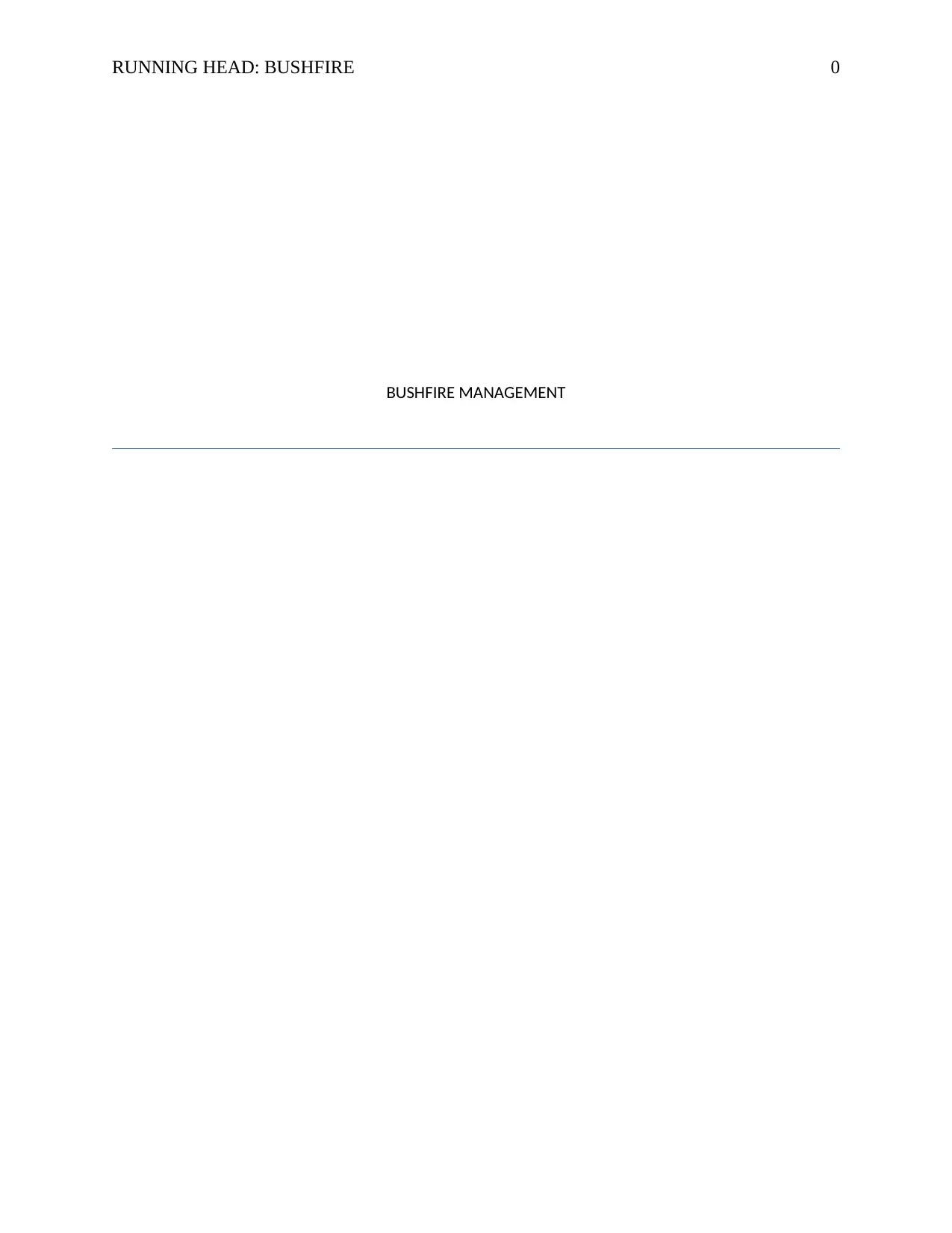
RUNNING HEAD: BUSHFIRE 0
BUSHFIRE MANAGEMENT
BUSHFIRE MANAGEMENT
Paraphrase This Document
Need a fresh take? Get an instant paraphrase of this document with our AI Paraphraser
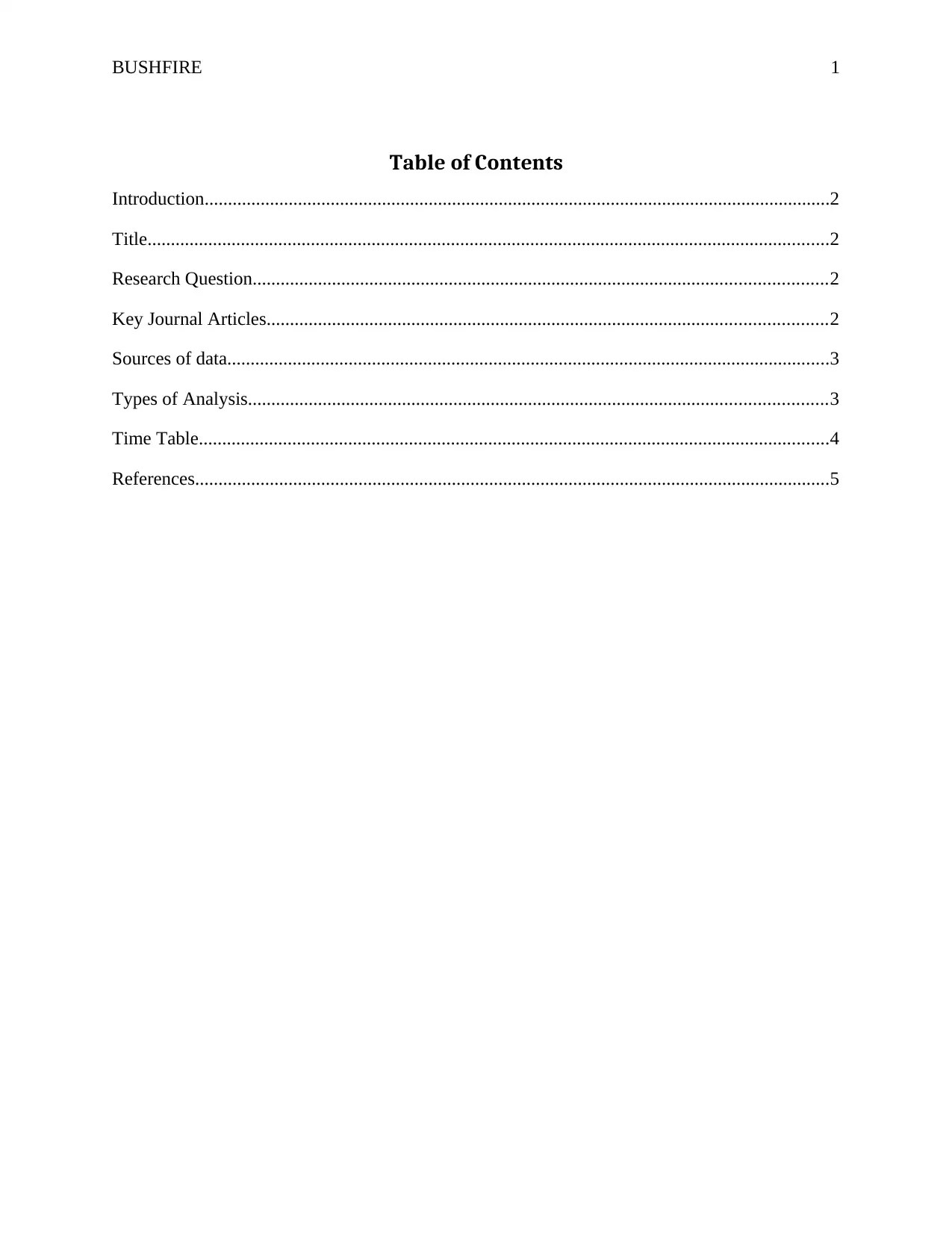
BUSHFIRE 1
Table of Contents
Introduction......................................................................................................................................2
Title..................................................................................................................................................2
Research Question...........................................................................................................................2
Key Journal Articles........................................................................................................................2
Sources of data.................................................................................................................................3
Types of Analysis............................................................................................................................3
Time Table.......................................................................................................................................4
References........................................................................................................................................5
Table of Contents
Introduction......................................................................................................................................2
Title..................................................................................................................................................2
Research Question...........................................................................................................................2
Key Journal Articles........................................................................................................................2
Sources of data.................................................................................................................................3
Types of Analysis............................................................................................................................3
Time Table.......................................................................................................................................4
References........................................................................................................................................5
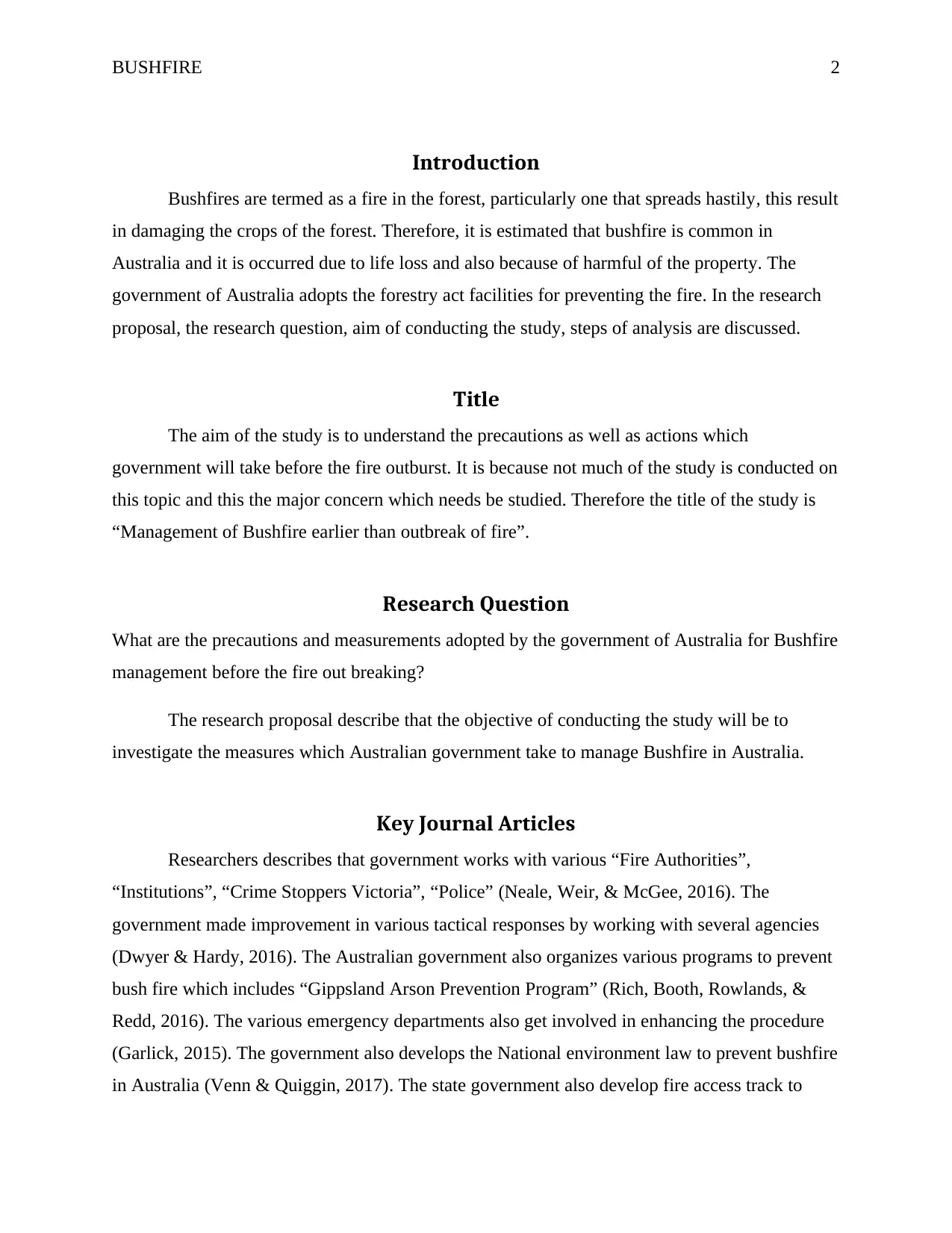
BUSHFIRE 2
Introduction
Bushfires are termed as a fire in the forest, particularly one that spreads hastily, this result
in damaging the crops of the forest. Therefore, it is estimated that bushfire is common in
Australia and it is occurred due to life loss and also because of harmful of the property. The
government of Australia adopts the forestry act facilities for preventing the fire. In the research
proposal, the research question, aim of conducting the study, steps of analysis are discussed.
Title
The aim of the study is to understand the precautions as well as actions which
government will take before the fire outburst. It is because not much of the study is conducted on
this topic and this the major concern which needs be studied. Therefore the title of the study is
“Management of Bushfire earlier than outbreak of fire”.
Research Question
What are the precautions and measurements adopted by the government of Australia for Bushfire
management before the fire out breaking?
The research proposal describe that the objective of conducting the study will be to
investigate the measures which Australian government take to manage Bushfire in Australia.
Key Journal Articles
Researchers describes that government works with various “Fire Authorities”,
“Institutions”, “Crime Stoppers Victoria”, “Police” (Neale, Weir, & McGee, 2016). The
government made improvement in various tactical responses by working with several agencies
(Dwyer & Hardy, 2016). The Australian government also organizes various programs to prevent
bush fire which includes “Gippsland Arson Prevention Program” (Rich, Booth, Rowlands, &
Redd, 2016). The various emergency departments also get involved in enhancing the procedure
(Garlick, 2015). The government also develops the National environment law to prevent bushfire
in Australia (Venn & Quiggin, 2017). The state government also develop fire access track to
Introduction
Bushfires are termed as a fire in the forest, particularly one that spreads hastily, this result
in damaging the crops of the forest. Therefore, it is estimated that bushfire is common in
Australia and it is occurred due to life loss and also because of harmful of the property. The
government of Australia adopts the forestry act facilities for preventing the fire. In the research
proposal, the research question, aim of conducting the study, steps of analysis are discussed.
Title
The aim of the study is to understand the precautions as well as actions which
government will take before the fire outburst. It is because not much of the study is conducted on
this topic and this the major concern which needs be studied. Therefore the title of the study is
“Management of Bushfire earlier than outbreak of fire”.
Research Question
What are the precautions and measurements adopted by the government of Australia for Bushfire
management before the fire out breaking?
The research proposal describe that the objective of conducting the study will be to
investigate the measures which Australian government take to manage Bushfire in Australia.
Key Journal Articles
Researchers describes that government works with various “Fire Authorities”,
“Institutions”, “Crime Stoppers Victoria”, “Police” (Neale, Weir, & McGee, 2016). The
government made improvement in various tactical responses by working with several agencies
(Dwyer & Hardy, 2016). The Australian government also organizes various programs to prevent
bush fire which includes “Gippsland Arson Prevention Program” (Rich, Booth, Rowlands, &
Redd, 2016). The various emergency departments also get involved in enhancing the procedure
(Garlick, 2015). The government also develops the National environment law to prevent bushfire
in Australia (Venn & Quiggin, 2017). The state government also develop fire access track to
⊘ This is a preview!⊘
Do you want full access?
Subscribe today to unlock all pages.

Trusted by 1+ million students worldwide
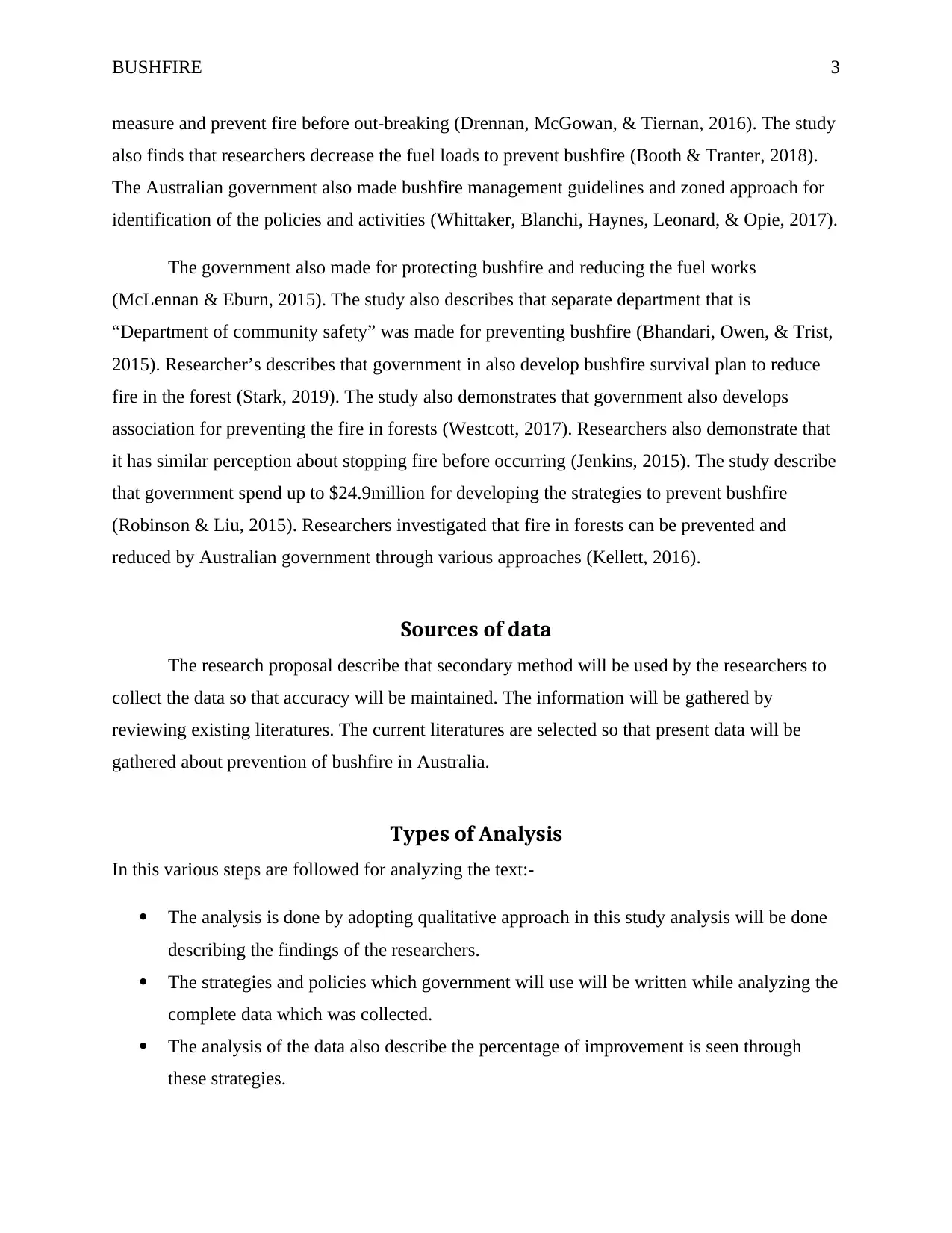
BUSHFIRE 3
measure and prevent fire before out-breaking (Drennan, McGowan, & Tiernan, 2016). The study
also finds that researchers decrease the fuel loads to prevent bushfire (Booth & Tranter, 2018).
The Australian government also made bushfire management guidelines and zoned approach for
identification of the policies and activities (Whittaker, Blanchi, Haynes, Leonard, & Opie, 2017).
The government also made for protecting bushfire and reducing the fuel works
(McLennan & Eburn, 2015). The study also describes that separate department that is
“Department of community safety” was made for preventing bushfire (Bhandari, Owen, & Trist,
2015). Researcher’s describes that government in also develop bushfire survival plan to reduce
fire in the forest (Stark, 2019). The study also demonstrates that government also develops
association for preventing the fire in forests (Westcott, 2017). Researchers also demonstrate that
it has similar perception about stopping fire before occurring (Jenkins, 2015). The study describe
that government spend up to $24.9million for developing the strategies to prevent bushfire
(Robinson & Liu, 2015). Researchers investigated that fire in forests can be prevented and
reduced by Australian government through various approaches (Kellett, 2016).
Sources of data
The research proposal describe that secondary method will be used by the researchers to
collect the data so that accuracy will be maintained. The information will be gathered by
reviewing existing literatures. The current literatures are selected so that present data will be
gathered about prevention of bushfire in Australia.
Types of Analysis
In this various steps are followed for analyzing the text:-
The analysis is done by adopting qualitative approach in this study analysis will be done
describing the findings of the researchers.
The strategies and policies which government will use will be written while analyzing the
complete data which was collected.
The analysis of the data also describe the percentage of improvement is seen through
these strategies.
measure and prevent fire before out-breaking (Drennan, McGowan, & Tiernan, 2016). The study
also finds that researchers decrease the fuel loads to prevent bushfire (Booth & Tranter, 2018).
The Australian government also made bushfire management guidelines and zoned approach for
identification of the policies and activities (Whittaker, Blanchi, Haynes, Leonard, & Opie, 2017).
The government also made for protecting bushfire and reducing the fuel works
(McLennan & Eburn, 2015). The study also describes that separate department that is
“Department of community safety” was made for preventing bushfire (Bhandari, Owen, & Trist,
2015). Researcher’s describes that government in also develop bushfire survival plan to reduce
fire in the forest (Stark, 2019). The study also demonstrates that government also develops
association for preventing the fire in forests (Westcott, 2017). Researchers also demonstrate that
it has similar perception about stopping fire before occurring (Jenkins, 2015). The study describe
that government spend up to $24.9million for developing the strategies to prevent bushfire
(Robinson & Liu, 2015). Researchers investigated that fire in forests can be prevented and
reduced by Australian government through various approaches (Kellett, 2016).
Sources of data
The research proposal describe that secondary method will be used by the researchers to
collect the data so that accuracy will be maintained. The information will be gathered by
reviewing existing literatures. The current literatures are selected so that present data will be
gathered about prevention of bushfire in Australia.
Types of Analysis
In this various steps are followed for analyzing the text:-
The analysis is done by adopting qualitative approach in this study analysis will be done
describing the findings of the researchers.
The strategies and policies which government will use will be written while analyzing the
complete data which was collected.
The analysis of the data also describe the percentage of improvement is seen through
these strategies.
Paraphrase This Document
Need a fresh take? Get an instant paraphrase of this document with our AI Paraphraser
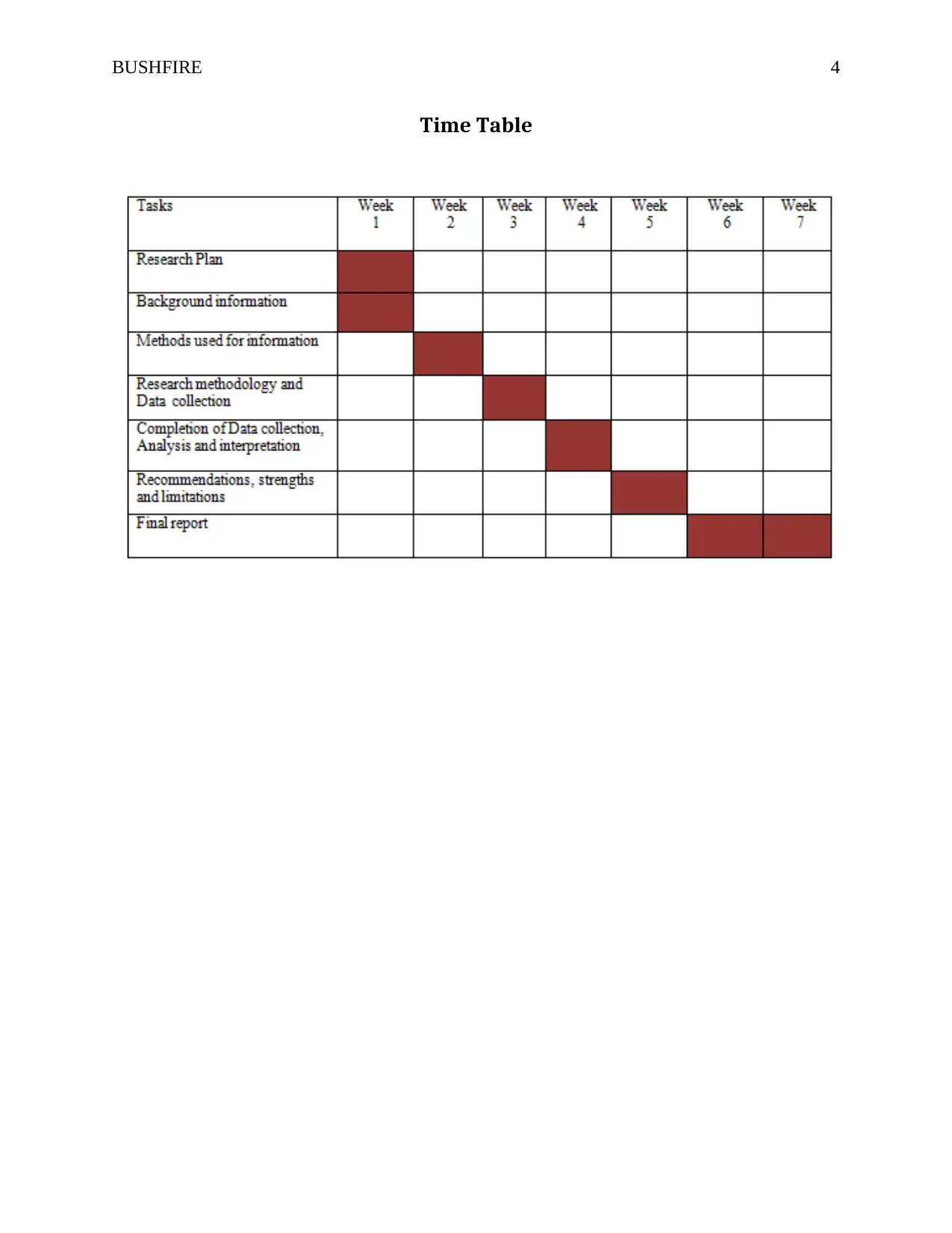
BUSHFIRE 4
Time Table
Time Table
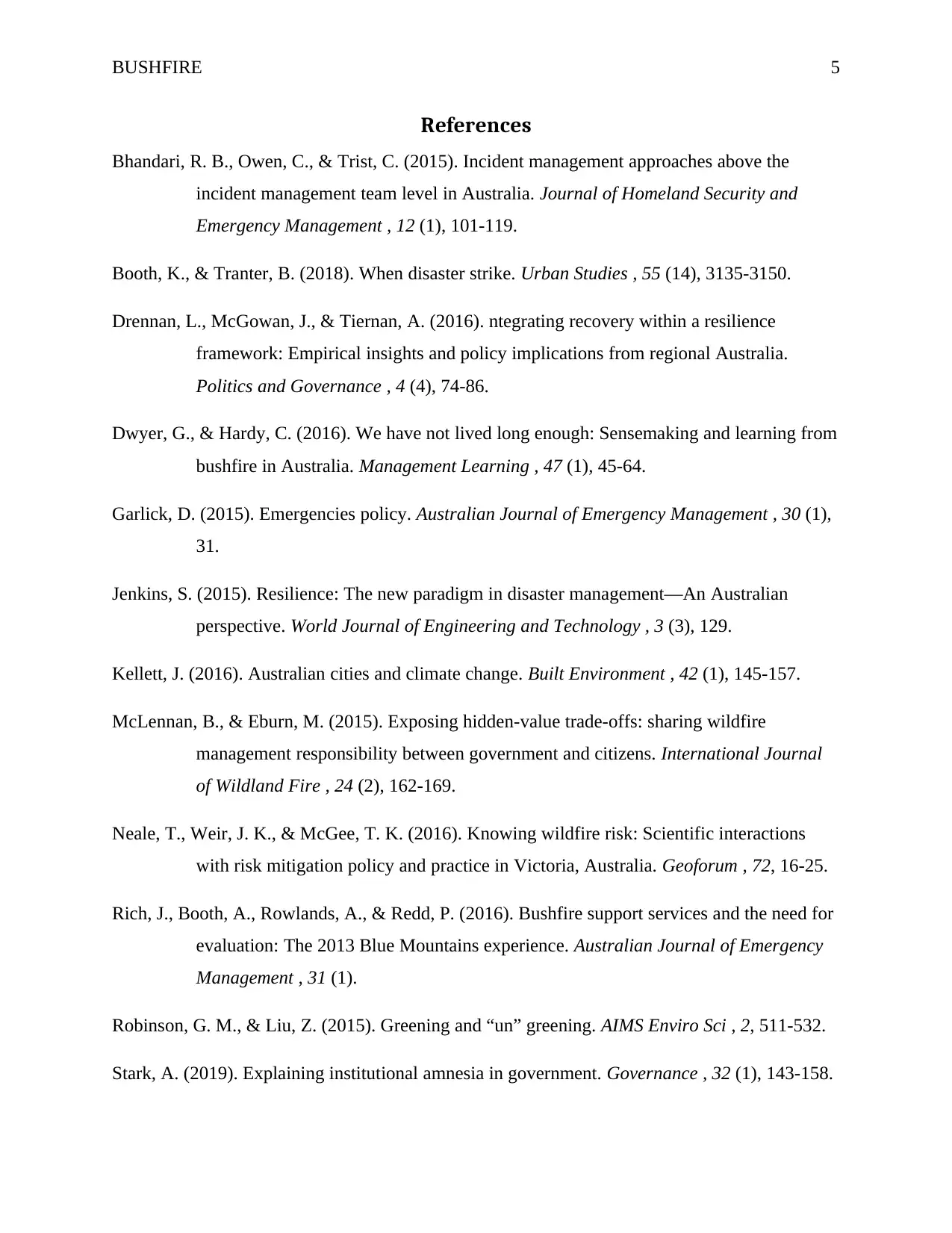
BUSHFIRE 5
References
Bhandari, R. B., Owen, C., & Trist, C. (2015). Incident management approaches above the
incident management team level in Australia. Journal of Homeland Security and
Emergency Management , 12 (1), 101-119.
Booth, K., & Tranter, B. (2018). When disaster strike. Urban Studies , 55 (14), 3135-3150.
Drennan, L., McGowan, J., & Tiernan, A. (2016). ntegrating recovery within a resilience
framework: Empirical insights and policy implications from regional Australia.
Politics and Governance , 4 (4), 74-86.
Dwyer, G., & Hardy, C. (2016). We have not lived long enough: Sensemaking and learning from
bushfire in Australia. Management Learning , 47 (1), 45-64.
Garlick, D. (2015). Emergencies policy. Australian Journal of Emergency Management , 30 (1),
31.
Jenkins, S. (2015). Resilience: The new paradigm in disaster management—An Australian
perspective. World Journal of Engineering and Technology , 3 (3), 129.
Kellett, J. (2016). Australian cities and climate change. Built Environment , 42 (1), 145-157.
McLennan, B., & Eburn, M. (2015). Exposing hidden-value trade-offs: sharing wildfire
management responsibility between government and citizens. International Journal
of Wildland Fire , 24 (2), 162-169.
Neale, T., Weir, J. K., & McGee, T. K. (2016). Knowing wildfire risk: Scientific interactions
with risk mitigation policy and practice in Victoria, Australia. Geoforum , 72, 16-25.
Rich, J., Booth, A., Rowlands, A., & Redd, P. (2016). Bushfire support services and the need for
evaluation: The 2013 Blue Mountains experience. Australian Journal of Emergency
Management , 31 (1).
Robinson, G. M., & Liu, Z. (2015). Greening and “un” greening. AIMS Enviro Sci , 2, 511-532.
Stark, A. (2019). Explaining institutional amnesia in government. Governance , 32 (1), 143-158.
References
Bhandari, R. B., Owen, C., & Trist, C. (2015). Incident management approaches above the
incident management team level in Australia. Journal of Homeland Security and
Emergency Management , 12 (1), 101-119.
Booth, K., & Tranter, B. (2018). When disaster strike. Urban Studies , 55 (14), 3135-3150.
Drennan, L., McGowan, J., & Tiernan, A. (2016). ntegrating recovery within a resilience
framework: Empirical insights and policy implications from regional Australia.
Politics and Governance , 4 (4), 74-86.
Dwyer, G., & Hardy, C. (2016). We have not lived long enough: Sensemaking and learning from
bushfire in Australia. Management Learning , 47 (1), 45-64.
Garlick, D. (2015). Emergencies policy. Australian Journal of Emergency Management , 30 (1),
31.
Jenkins, S. (2015). Resilience: The new paradigm in disaster management—An Australian
perspective. World Journal of Engineering and Technology , 3 (3), 129.
Kellett, J. (2016). Australian cities and climate change. Built Environment , 42 (1), 145-157.
McLennan, B., & Eburn, M. (2015). Exposing hidden-value trade-offs: sharing wildfire
management responsibility between government and citizens. International Journal
of Wildland Fire , 24 (2), 162-169.
Neale, T., Weir, J. K., & McGee, T. K. (2016). Knowing wildfire risk: Scientific interactions
with risk mitigation policy and practice in Victoria, Australia. Geoforum , 72, 16-25.
Rich, J., Booth, A., Rowlands, A., & Redd, P. (2016). Bushfire support services and the need for
evaluation: The 2013 Blue Mountains experience. Australian Journal of Emergency
Management , 31 (1).
Robinson, G. M., & Liu, Z. (2015). Greening and “un” greening. AIMS Enviro Sci , 2, 511-532.
Stark, A. (2019). Explaining institutional amnesia in government. Governance , 32 (1), 143-158.
⊘ This is a preview!⊘
Do you want full access?
Subscribe today to unlock all pages.

Trusted by 1+ million students worldwide

BUSHFIRE 6
Venn, T. J., & Quiggin, J. (2017). Early evacuation is the best bushfire risk mitigation strategy
for south‐eastern Australia. Australian Journal of Agricultural and Resource
Economics , 61 (3), 481-497.
Westcott, R. (2017). Narrowing the awareness-action gap: Cultivating fire-fitness as a social
norm through public policy initiatives. Australian Journal of Emergency Management
, 32 (4), 37.
Whittaker, J., Blanchi, R., Haynes, K., Leonard, J., & Opie, K. (2017). Bushfires: Implications
for policy and research. International journal of disaster risk reduction , 23, 119-127.
Venn, T. J., & Quiggin, J. (2017). Early evacuation is the best bushfire risk mitigation strategy
for south‐eastern Australia. Australian Journal of Agricultural and Resource
Economics , 61 (3), 481-497.
Westcott, R. (2017). Narrowing the awareness-action gap: Cultivating fire-fitness as a social
norm through public policy initiatives. Australian Journal of Emergency Management
, 32 (4), 37.
Whittaker, J., Blanchi, R., Haynes, K., Leonard, J., & Opie, K. (2017). Bushfires: Implications
for policy and research. International journal of disaster risk reduction , 23, 119-127.
1 out of 7
Related Documents
Your All-in-One AI-Powered Toolkit for Academic Success.
+13062052269
info@desklib.com
Available 24*7 on WhatsApp / Email
![[object Object]](/_next/static/media/star-bottom.7253800d.svg)
Unlock your academic potential
Copyright © 2020–2025 A2Z Services. All Rights Reserved. Developed and managed by ZUCOL.





